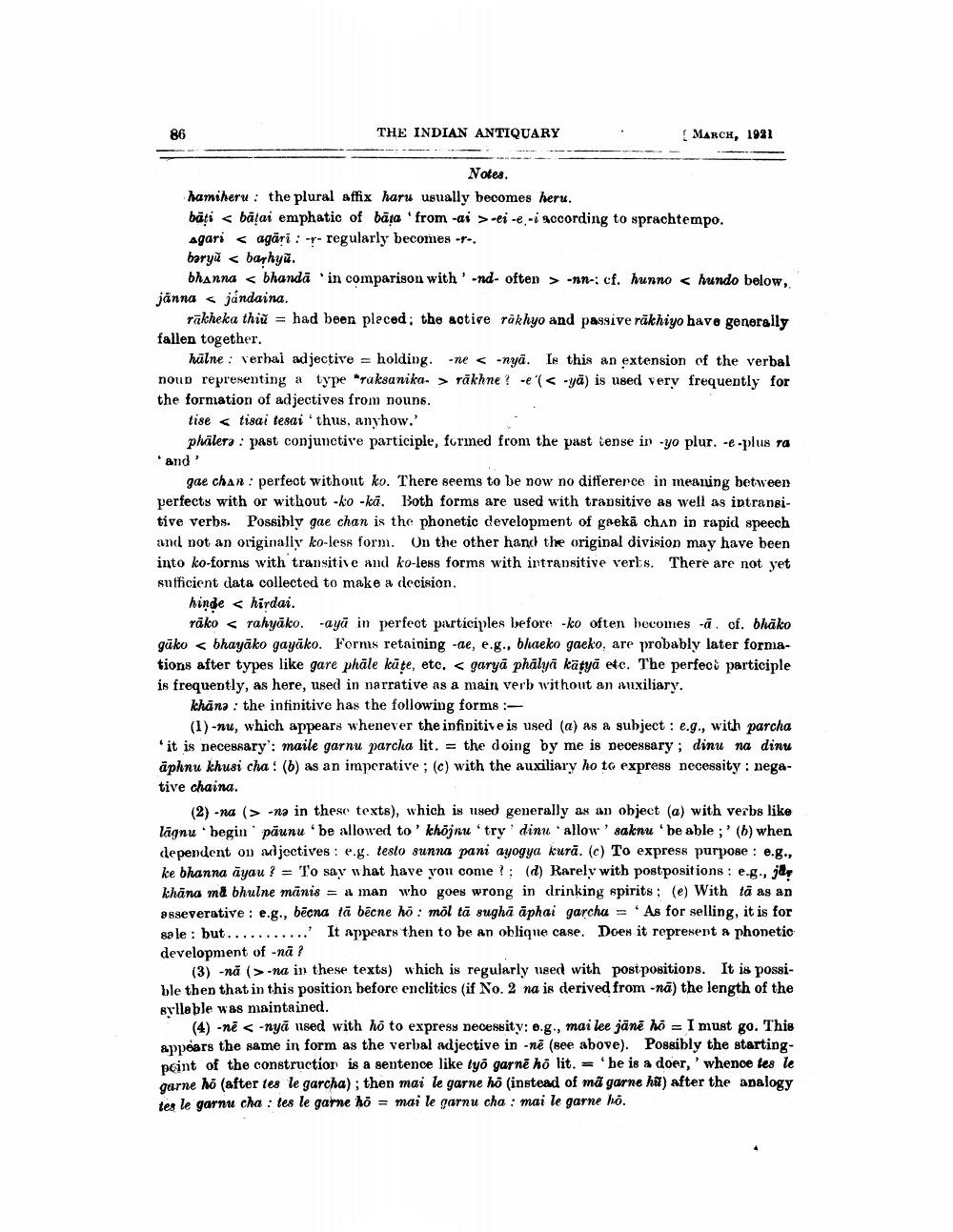________________
THE INDIAN ANTIQUARY
MARCH, 1921
Notes. hamiheru : the plural affix haru usually becomes heru. bäti < bâtai emphatic of bāra 'from-ai > -ei-e-i according to sprachtempo. agari < agāri: -r- regularly becomes - baryū < barhyū.
bhanna < bhandā 'in comparison with '-nd- often > nn-: cf. hunno < hundo below, jänna s jandaina.
rākheka thiū = had been placed, the active rākhyo and passive räkhiyo have generally fallen together.
hūlne : verhal adjective = holding. -nes-nya. Is this an extension of the verbal nous representing a type mraksanika. > rakhne? -el<-yä) is used very frequently for the formation of adjectives from nouns.
tise < tisai tesai 'thus, anyhow.'
phülera : past conjunctive participle, formed from the past tense in -yo plur. -e-plus ta *and'
gae chan: perfect without ko. There seems to be now no difference in meaning between perfects with or without -ko -kā. Both forms are used with transitive as well as intransitive verbs. Possibly gae chan is the phonetic development of gaekā chan in rapid speech and not an originally ko-less form. On the other hand the original division may have been into ko-forms with transitive and ko-less forms with intransitive verks. There are not yet sufficient data collected to make a decision.
hinde < hirdai.
rākos rahyāko. -ayā in perfect participles before -ko often becomes -a. of. bhäko gūko < bhayāko gayāko. Forms retaining -ae, e.g., blaeko gaeko, are probably later formations after types like gare phäle küte, etc. < garyā phālyä kätyä etc. The perfect participle is frequently, as here, used in narrative as a main verb without an auxiliary.
khāna : the infinitive has the following forms :
(1)-nu, which appears whenever the infinitive is used (a) as a subject : e.g., with parcha it is necessary': maile garnu parcha lit. = the doing by me is necessary; dinu na dinu āphnu khusi cha : (b) as an imperative; (c) with the auxiliary ho to express necessity : negative chaina.
(2) -na (> .na in these texts), which is used generally as an object (a) with verbs like lagnu begin päunu be allowed to 'khöjnu 'try'dinu ' allow' saknu "be able ;' (b) when dependent on adjectives: e.g. testo sunna pani ayogya kurā. (c) To express purpose : e.g., ke bhanna āyau? = To say what have you come ? ; (d) Rarely with postpositions : e.g., jy khāna ma bhuine mänis = a man who goes wrong in drinking spirits; (e) With tå as an obseverative: e.g., bēcna tā bēcne ho: mõl tā sughā āphai garcha = " As for selling, it is for sa le : but...........' It appears then to be an oblique case. Does it represent a phonetic development of -nä?
(3) -nă (>-na in these texts) which is regularly used with postpositions. It is possible then that in this position before enclitics (if No. 2 na is derived from -nā) the length of the bylleble was maintained.
(4) -nē -nyā used with ho to express necessity: 0.g., mai lee jānē ho = I must go. This appears the same in form as the verbal adjective in - nē (see above). Possibly the startingpoint of the construction is a sentence like työ garnē hö lit. = 'be is a doer,' whence tes le garne ho (after tes le garcha); then mai le garne ho (instead of mã garne hat) after the analogy tes le garnu cha : tes le garne ho = mai le garnu cha : mai le garne ho.




